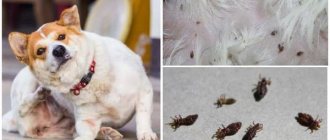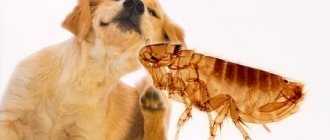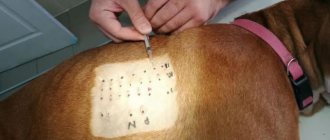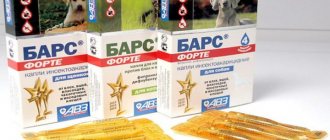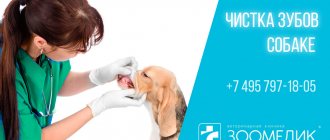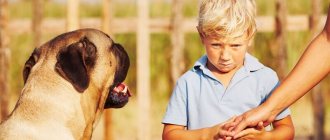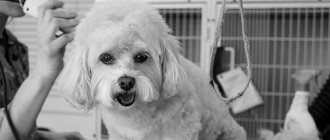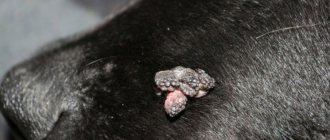The appearance of fleas in a dog always causes concern for the owner, who monitors his own health and the health of his pet. This is the correct reaction, because fleas are carriers of many diseases that are dangerous to both animals and humans.
A flea is a blood-sucking insect that parasitizes warm-blooded animals and humans. They feed on the blood of their owner, biting through his skin. The size of dog fleas is about 3 mm. They have increased fertility: the female lays up to 25 eggs per day. Insects have developed jumping ability, so they can easily jump from a dog to another animal or to people.
The mechanism of transmission of pathogens of various diseases: a flea, having drunk blood from a sick animal or person, bites another “food item” and introduces an infection into the wound, from which pathogenic viruses and bacteria spread through the bloodstream. This is how infection occurs.
Causes and signs of fleas
Every dog gets fleas from time to time. Even animals living in an apartment are not immune from this scourge. Fleas make jumps up to 30 cm in height and length, which means that you can “pick up” a flea anywhere.
Most often, fleas settle on dogs after the following episodes:
- a walk in the courtyard of the house;
- visiting a park or forest;
- traveling on public transport;
- participation in exhibitions;
- contact with another animal (cat, rabbit, rat, mouse, dog).
People can also bring fleas into the house - on clothes or shoes.
The first sign that your pet has fleas is frequent scratching. In this way, the animal tries to get rid of the annoying insect. The sign of a bite can be detected by parting the fur. A small red spot with a drop of dried blood is clearly visible on the skin.
Photo
In the photo below you can see what the main sign looks like - waste products of fleas in the dog's fur.
How dangerous are blood-sucking parasites for humans?
Dog fleas do not live on a person, but they can bite if they are on his body. The most “innocent” consequence is skin irritation at the site of the bite. This is how a local allergic reaction is expressed. If you scratch this wound, there is a risk of causing a so-called “secondary infection.” In this case, the bite site festers, and pathogenic microflora enters the body through the bloodstream. If left untreated, sepsis (blood poisoning) may occur.
A flea can infect humans with the following diseases:
- brucellosis – multiple lesions of the human body systems (cardiac, digestive, motor, reproductive, etc.);
- helminthiasis - parasitic worms that settle in the digestive and other systems of the body;
- encephalitis – brain damage;
- salmonellosis - an acute infection of the gastrointestinal tract;
- tularemia – damage to the lymph nodes and severe intoxication of the body.
Any of the listed diseases caused by fleas from a dog is a serious test for the body and never goes away without consequences.
Parasitic insects can cause a lot of problems for your pet. Flea bites are very irritating to dogs, they become nervous, eat less well and sleep poorly. Scratching flea bites leads to ulcers and hair loss. This disease is called flea dermatitis.
In addition, fleas can infect a dog with the following diseases:
- cucumber tapeworm (dipylidia) is a tapeworm up to 70 cm long that parasitizes the small intestine of an animal. Infection occurs when an animal ingests an infected flea;
- distemper is an infectious disease that affects the mucous membranes and central nervous system of an animal;
- brucellosis;
- anemia (anemia) if the dog has a lot of fleas.
Considering the listed diseases that can result from bites of blood-sucking parasites, the question of how to remove fleas from a dog is very relevant.
Treating the premises where the animal lives
If a dog has fleas, it is necessary to treat the apartment where it lives and its sleeping place. If only the animal is treated, the insects may return when the drug wears off.
Apartment processing
The room is processed in the following ways:
- Chemical. These are solutions, powders and sprays containing insecticides - fipronil, permethrin, organophosphorus compounds. Solutions are used to treat surfaces, powders are poured where fleas can live - in all corners, in furniture, under window sills and baseboards. Aerosols have a faster effect, but only with direct contact with parasites. The most effective products are Phenaxin powder, Karbofos concentrate, Raid and Raptor sprays.
- Mechanical. Insects die if all the doors and windows in the house are opened for several hours in frosty winter. But in this case, damage to engineering communications may occur. If it is precisely established where the fleas live, it is recommended to scald the area with boiling water.
- Professional. In this case, they call specialists who treat the room with cold or hot fog. The smallest drops of insecticidal solution can penetrate into the most inaccessible places, destroying all insects.
- Folk. To get rid of parasites, use pine sawdust, kerosene, wormwood, etc. Insects die only after treatment with kerosene; other methods are used as additional ones. Plants are used to prepare decoctions and infusions, then wipe all surfaces in the room with the liquid several times a day.
Review of flea products for dogs
You can remove fleas from a dog at home without much effort and with a minimal investment of time and money using commercially produced products. These drugs contain substances that either repel fleas, have a destructive effect on their central nervous system, or render their offspring unviable.
Plant and synthetic insecticides are used as active substances in the production of flea products.
The most effective of them are the following:
- pyrethrins – made from natural raw materials, they have a gentle effect on the dog’s body without causing intoxication. Fleas die from paralysis of the central nervous system;
- pyrothroids are synthetic analogues of pyrethrins. They have a more powerful effect, therefore they are not used in products intended for the extermination of fleas in dogs during puppyhood;
- imidacloprid and clothianidin are nicotine derivatives that have a toxic effect on insects, but do not harm the animal;
- diazinon and fipronil - cause paralysis in fleas;
- selamectin - helps kill not only fleas, but also ear mites, as well as some types of helminths.
Modern anti-flea agents, as a rule, combine several types of active substances and therefore have a combined effect on several types of parasitic insects.
The dosage of the active substance, as a rule, depends on the weight of the dog and its age. It is important to remember that products for an adult animal are not suitable for puppies or pregnant dogs. Therefore, you should carefully study the instructions for the drug before using it.
Shampoo
Shampoo is the mildest flea treatment for dogs. It contains either insecticides or essential oils in a minimal dosage. Therefore, shampoos can be classified more as a hygienic and preventive product than as a therapeutic one.
It is important that when washing the dog, the shampoo foam does not get on the mucous membranes of the dog’s mouth or eyes. If this does happen, then it is necessary to immediately rinse the animal’s mucous membranes with plenty of clean water.
Flea shampoos for dogs are classified depending on the active substances they contain:
- insectoacaricidal - one of the components is a plant or synthetic insecticide in a minimum concentration that kills adult fleas and their larvae. The effect of this shampoo is up to 3 months (depending on the active substance used). Such products include “Mister Bruno” shampoos from the manufacturer Fitoelite;
- natural – the shampoo contains essential oils that repel fleas from dogs with their scent. The action lasts for 1 week. This product is suitable for small puppies, old and pregnant dogs. For example, “Green Fort” shampoo from the German company Neoterica, Russian “Doctor Zoo”;
- combined - contain both repellents and insecticides. The action lasts up to 3 weeks. Such shampoos include: “Lugovoy”, “Clandestine”.
Benefits of using flea shampoo:
- low toxicity;
- ease of use;
- the ability to simultaneously remove street dirt, house dust, mites (ear and forest mites), lice-eaters, and fly larvae.
Drops
Flea drops for dogs are the most effective and easy-to-use remedy for killing fleas on animals. To produce drops, “shock” dosages of active substances are used that destroy or expel parasitic insects. The drops are applied to the dogs' withers, after spreading the fur.
The duration of action depends on the concentration of the active substance. To avoid re-infestation, the drug must be applied again as soon as the period of exposure to the drops after the previous application has expired. This is especially important for dogs that are often free-range.
Pet owners should remember that the amount of flea medication for dogs is calculated based on the weight of the animal being treated. An overdose can result in severe intoxication of the body.
Drops that have been successfully tested and are popular among dog breeders and recommended by veterinarians:
- "Stronghold" from the American manufacturer Zoetis. The active substance – selamectin, effectively destroys fleas and ticks at all stages of development, does not have a harmful effect on the health of the dog;
- "Bars" of domestic production. The active elements are the insecticides praziquantel and ivermectin. The drug can be used by puppies from 2 months.
Many anti-flea drops have been developed; it is impossible to list them in one article. You can choose the best option for your dog experimentally or by consulting a veterinarian.
Prevention of infection
Use collars as a preventative measure after treatment with drops and sprays, but only after two to three weeks. The duration of action of the active substance is from 2 to 7 months. Cost from 80 rub. up to 1.5 thousand rubles To prevent infection, place branches of wormwood, lemon balm, lavender around the house, fill the litter with sawdust from coniferous trees - pine, juniper, spruce. Be sure to give your dog an anti-helminth medication after removing fleas to eliminate the risk of infection. After all, fleas are active carriers of tapeworms and other parasites. Don't forget that you too have been in contact with an infected animal. Take care of prevention for yourself and your loved ones.
Video
Pills
Flea tablets for dogs are an innovation in the veterinary market. For the first time, you can not apply flea treatment to the animal, but let it take it orally.
Benefits of taking the pills:
- some types of tablets can be used for both adult dogs and puppies, pregnant and old dogs, having previously calculated the dosage;
- no side effects;
- After taking the tablets, the dog can be petted; there are no traces of insecticides on the fur.
The mechanism of action of flea tablets in dogs: the drug, entering the digestive system, penetrates the animal’s blood. A flea, having bitten the skin of a dog, receives a portion of the toxin, from which it dies.
All tablets sold in veterinary pharmacies have been vetted. control, therefore safe for the health of dogs. The most popular drugs are:
- “Bravecto” (Austria/Netherlands) – tablets are taken once every 3 months;
- “Frontline Nexgard” (France) – a single dose lasts 4 weeks;
- "Simparinka" (Zoetis) - taken once every 35 days.
All drugs have certain contraindications, so be sure to read the instructions.
Collar
A flea collar for dogs is a strap made of porous material, impregnated with a substance that kills or repels fleas. Worn around the neck, designed to prevent the appearance of parasitic insects. It is impossible to cure an animal of fleas using this remedy alone. The fact is that the collar is intended to be worn constantly, so its impregnation contains active components in minimal quantities so as not to harm the dog’s health.
Important: collars for puppies under 2 months are not recommended.
Experts note the effectiveness of many types of collars. For example, “Fitodoc” based on natural repellents, “Rolf club 3D”, which repels almost all types of blood-sucking insects.
How to remove fleas from a dog at home
You can treat your dog for fleas either yourself or by going to a veterinary clinic.
Since the dog began to live in a person’s house, people began to look for means to rid animals and their homes of fleas. Some of the folk remedies are very effective. For example, you can exterminate insects that have settled in carpets in a simple and cheap way: with a mixture of salt and soda. Salt has powerful dehydrating properties, so when it hits an insect, it literally dries it out. Baking soda is toxic to flea eggs and larvae.
What should be done:
- mix soda and fine table salt in equal proportions;
- apply to carpets with a brush or broom;
- leave for 10 - 12 hours, and then clean the carpet with a vacuum cleaner.
This procedure must be repeated every 4 days for 2 weeks.
To remove fleas from a dog at home, you can use wormwood tincture. Recipe:
- you need to collect and dry wormwood;
- grind the grass and pour vodka into it. Approximate proportions: ½ cup of crushed wormwood to 1 cup of vodka;
- leave for 2 weeks in a dark place and strain.
An aqueous solution of this tincture should be used to thoroughly treat all of the animal’s fur. Solution proportions: 1/3 cup of tincture per ½ liter of water.
Only a few people can afford to waste time going out of town to collect herbal remedies for fleas or spray the room with salt and soda several times. Therefore, veterinary companies develop and produce a wide variety of products that allow you to destroy the block without harm to your pet.
A modern view of the problem of helminthiasis in children and effective ways to solve it
According to the World Health Organization, of the 50 million people who die annually in the world, more than 16 million are caused by infectious and parasitic diseases. In the structure of infectious diseases, intestinal helminthiases are in third place. The World Bank estimates that the economic cost of intestinal helminthiases ranks fourth among all diseases and injuries. Given the importance of the control of parasitic diseases for many countries, the 54th World Health Assembly in 2001 approved a strategy for the control of soil helminthiasis until 2010 [5].
In the Russian Federation, more than 10 million people are examined annually for helminth infections, most of them are children. In 2002, 813 thousand infected were identified, of which 681 thousand (83.8%) were children under the age of 14 [4]. More than 15 types of helminths are found in children, of which the most common are enterobiasis, ascariasis, opisthorchiasis, diphyllobothriasis, trichocephalosis, and hymenolepiasis. In recent years, toxocariasis has been increasingly recorded, which is associated with the widespread introduction into practice of a diagnostic test system for its detection.
In the structure of helminthiasis, the leading place is occupied by enterobiasis (91%) and ascariasis (8%). Among all infected children, 92.3% of cases of enterobiasis, 71.1% of ascariasis, 61.5% of trichuriasis and 66.2% of toxocariasis occur.
The incidence of enterobiasis and ascariasis in children in rural areas is significantly higher than in cities, which is apparently due to different sanitary and hygienic conditions in child care institutions in the city and village, as well as the degree of contamination of the environment with helminth eggs (Fig. 5).
Ascariasis is one of the most common helminthiasis, in the formation of foci of which soil contamination with ascaris eggs is of primary importance. In 2002, 74,196 cases of ascariasis were identified, including 52,801 in children under 14 years of age; compared to 2001, the incidence increased by 3.5% and amounted to 217.7 per 100 thousand children.
The incidence of trichuriasis, with a clear downward trend over the last decade, in 2002 increased by 2.8% and amounted to 7.4 per 100 thousand children. Trichocephalosis is registered mainly in the Southern Federal District (Republic of Dagestan, Chechen Republic).
Enterobiasis still ranks first in terms of prevalence among other helminthiases. In 2002, 614,955 cases of the disease were registered among children, which amounted to 2535.5 per 100 thousand patients.
The maximum number of people infected with enterobiasis in 2002 was identified in the Siberian, Northwestern, Ural, Far Eastern, and Volga federal districts.
A feature of most helminthiasis is the chronic course of the disease, associated with the long-term presence of the pathogen in the body and repeated repeated infections. Helminth infections in children, as a rule, are accompanied by a variety of nonspecific clinical manifestations: weakness, fatigue, irritability, sleep disturbances, dyspeptic symptoms, slower growth and weight gain, and decreased immune status. The most important component of the pathology of helminth infections is the sensitizing effect of metabolic products and excretion of helminths, leading to the development of allergic reactions in the form of atopic dermatitis, asthmatic bronchitis, rhinitis, blepharitis, etc.
A selective analysis of the results of clinical examination of 520 children, carried out in the Sverdlovsk region of Perm in 2002, showed that ascariasis was detected in 1.35%, and enterobiasis in 5.8% of those examined. At the same time, on average, the number of health problems per child in children with enterobiasis in the group of preschoolers was 2.5, and in schoolchildren - 2.9. More often than others, diseases of the genitourinary system (in girls), allergic dermatitis, anemia, vegetative dystonia syndrome, neuropathic conditions and diseases of the gastrointestinal tract were noted. Of the diseases diagnosed in children with ascariasis, the most common were vegetative dystonia syndrome, functional diseases of the gastrointestinal tract, pneumonia, and allergic dermatitis. Among children with ascariasis, the incidence rate per child averaged 2.0. In the control group, which included children without parasitic diseases (37 people), the average number of health problems was significantly lower than among those infected with ascariasis and enterobiasis, and amounted to 0.2. Thus, the presence of ascariasis and enterobiasis leads to a deterioration in the general health of children. At the same time, children with various underlying diseases that lead to weakening of the body are more often infected with them.
Let us dwell in more detail on the importance of the most common helminthiasis in the development of pathology in children - ascariasis and enterobiasis [1, 3].
Ascariasis. The development of the causative agent of ascariasis (Fig. 2, 3) in the human body occurs with the migration of larvae emerging from the eggs along the bloodstream through the lungs; the larvae are then swallowed with sputum and develop into adults in the intestine. The lifespan of roundworm in the human body is several months. Ascariasis has a significant impact on the quality of nutrition and immunological mechanisms in children. Ascaris allergen is the most powerful of allergens of parasitic origin. It can cause reactions in the lungs, skin, conjunctiva, and gastrointestinal tract. Allergic reactions can be so severe that they often pose a threat to the child’s life.
The immunosuppressive effect of roundworms is due to the lack of effect of vaccination and revaccination against measles, diphtheria, tetanus, and polioviruses in children.
The leading mechanisms of pathogenesis of the migratory stage of ascariasis are the traumatic effect of larvae and sensitization by parasitic antigens. In this case, 2 main types of lesions occur in different organs and tissues.
- The traumatic effect of migrating larvae in organs and tissues along the migration route. At the beginning of migration, the larvae are still small (no more than 0.5 mm long) and cause limited hemorrhages in the wall of the small intestine and in the liver. By the end of migration, the larvae reach 2 mm in size and, penetrating into the alveoli and bronchioles, and then into the bronchi, cause more significant hemorrhages.
- Eosinophilic inflammation of the tissues in which the larvae develop. The tissue phase of ascariasis occurs during the migration of ascaris larvae to the liver and lungs. The metabolites released in this process cause serious immunological changes and inflammatory reactions. In the migration phase, ascariasis can cause hepatomegaly and asthmatic syndrome. In this case, the clinical picture resembles respiratory allergosis.
In the intestinal phase of ascariasis, important pathogenetic factors are the ability of roundworms, reaching a length of 20–40 cm, to spiral forward movements and the desire to penetrate small openings (Vater's nipple, drainage tubes, etc.). The presence of invasion leads to hypertrophy of the muscular layers of the intestinal wall, a decrease in the depth of the crypts, changes in the chemical composition of the intestinal contents, and disruption of the motor-secretory function of the stomach and intestines. Roundworms secrete inhibitors of trypsin and chemotrypsin, as a result of which the absorption of nutrients, proteins, and fats worsens. With ascariasis, functional deficiency of pyridoxine develops, the level of retinol and ascorbic acid decreases, and lactase tolerance decreases. Ascariasis is usually accompanied by intestinal dysbiosis.
Often symptoms of the intestinal phase of ascariasis are nausea, vomiting, diarrhea, fatigue, dizziness, poor sleep, and abdominal pain. An increased level of eosinophils in the peripheral bloodstream is characteristic of the migratory phase of ascariasis.
Complications of the intestinal phase of ascariasis: intestinal obstruction caused by a ball of adult roundworms; peritonitis due to perforation of the intestinal wall or penetration of roundworms into the abdominal cavity through a surgical suture; obstructive jaundice during migration of helminths into the common bile duct; blockage of the pancreatic ducts; asphyxia due to the migration of roundworms into the upper respiratory tract.
Enterobiasis. The development of the enterobiasis pathogen (Fig. 1) in the human body occurs within the gastrointestinal tract. The larvae emerge from the eggs (Fig. 4) and, on average, develop into adults within 2 weeks, which parasitize the lower parts of the small intestine and the upper parts of the large intestine. The lifespan of pinworms can reach 100 days, and the state of infestation in children due to repeated infections can last much longer.
| Figure 1. Life cycle of the enterobiasis pathogen (according to HC Jeffrey, RM Leach, 1975) |
Inflammatory reactions during enterobiasis develop under the influence of larvae, which produce hyaluronidase, proteolytic enzymes, lectin-like substances that promote the activation of the complement system, the release of prostaglandins by the cells of the host tissues surrounding the helminth [1, 2, 3].
With enterobiasis, the processes of absorption and digestion of food products are disrupted. In 30–40% of infected people, the acidity of gastric juice decreases, up to anacidosis and inhibition of pepsin-forming function. In most children, the intestinal microbiocenosis changes. Impaired absorption and digestion of nutrients in the intestines lead to weight loss and delay the growth and development of the child.
An additional factor in the pathogenesis of enterobiasis is the mechanical effect of pinworms in the intestines, leading to pinpoint hemorrhages, erosions, and penetration of bacterial flora, in particular pathogens of intestinal infections.
A striking symptom of enterobiasis is perianal itching, which occurs when the female moves during oviposition (Fig. 6). Severe itching occurs, as a rule, during sleep, more often at night, from 23.00 to 1.00 am. It is at this time that helminths can, remaining unnoticed, lay eggs that will mature to the invasive, contagious stage by the morning. Despite its apparent harmlessness, perianal itching is difficult for children to tolerate and can persist for quite a long time after enterobiasis is cured as a result of the formation of a persistent focus of excitation in the cerebral cortex. Complications that arise as a result of perianal itching are skin damage when scratching, perianal pruritis, eczema, weeping dermatitis. The etiological agent of the inflammatory process is most often streptococci.
| Figure 2. Roundworm egg (70 microns) |
| Figure 3. Adult roundworms |
| Figure 4. Pinworm egg (50–60 µm) |
Abdominal pain is a common symptom of enterobiasis. Pain of a transient nature is observed in the majority of infected people. Sometimes acute abdominal pain may be the reason to seek surgical help. In such cases, it is often not possible to detect a specific pathology; only the accumulation of gases is detected.
In recent years, the number of cases of the formation of perianal granulomas or abscesses in children, inside which female pinworms or helminth eggs were found, has increased. In this regard, it is advisable to screen all children with these conditions for enterobiasis.
In many cases, enterobiasis occurs over a long period of time and is repeated many times. As a result, the intestinal biocenosis is disrupted and the antagonistic properties of the intestinal microflora in relation to pathogens of acute intestinal infections are reduced. In the majority of infected children, the number of E. coli decreases and the proportion of lactonegative intestinal flora increases. The activity of enterokinase and alkaline phosphatase in feces increases. Since the intestinal microflora is one of the factors that supports the activity of intestinal enzymes, disturbances in the processes of digestion and absorption of nutrients that develop as a result of enterobiasis lead to loss of body weight and retard the growth and development of the child. Pinworms have a mechanical effect on the intestinal mucosa, which leads to pinpoint hemorrhages, erosions, and penetration of bacterial flora, in particular pathogens of intestinal infections. The antagonistic properties of the flora in relation to the causative agents of typhoid fever and other intestinal infections are reduced [1, 3].
If pinworms migrate into the abdominal cavity, urinary and genital tracts, inflammatory and allergic reactions outside the intestine may develop.
| Figure 5. Incidence of enterobiasis and ascariasis in urban and rural children in 2002. |
One of the common complications of enterobiasis is vulvovaginitis due to the penetration of pinworms into the genital tract and the addition of bacterial infections. If vulvovaginitis develops in a girl, a parasitological examination for enterobiasis should be prescribed and, if the result is positive, this invasion should be treated with simultaneous bacteriological examination and, if necessary, antibacterial therapy.
Against the background of enterobiasis, children often develop urinary tract infections, especially girls, since enterobiasis is a factor predisposing to the development of this complication.
Parasitism by pinworms in children leads to suppression of nonspecific immunity, manifested by a decrease in the level of interferon a in the blood serum. A decrease in the nonspecific resistance of the child’s body leads to an increase in the incidence of viral and bacterial infections.
| Figure 6. Tail end of a female pinworm |
The presence of enterobiasis leads to a decrease in the effectiveness of preventive vaccinations. The immune layer against diphtheria was initially lower among children infected with pinworms. Protective immunity does not develop during primary vaccination against this dangerous infection, and during revaccination in many cases there is no immune response. It is difficult to develop immunity when vaccinated against measles and tetanus, so to increase the effectiveness of vaccinations, you first need to make sure that the child’s body is free from helminthiasis pathogens.
In children with allergic diseases, enterobiasis develops much more often. Due to the relatively high probability of detecting enterobiasis in children with allergic diseases, patients in this group should be recommended to be examined for enterobiasis and deworming if infestation is detected.
Enterobiasis negatively affects the neuropsychic development of children. This invasion leads to a lag behind the corresponding age norms. Among those infected with enterobiasis, there is a high percentage of irritable children, with a disruption in the process of falling asleep, and with negative habits (biting nails, sucking fingers, etc.).
With enterobiasis in children, the level of copper, zinc and magnesium in the blood decreases significantly. Since the lack of these microelements can negatively affect the physical and mental development of children, their loss should be compensated by introducing certain foods into the child’s diet, prescribing medications (or nutritional supplements) until these indicators are normalized after enterobiasis is cured.
Main indications for examination for helminth infections:
- stomach ache;
- frequent nausea, vomiting;
- diseases of the gastrointestinal tract;
- fatigue, irritability, restless sleep, grinding teeth in sleep;
- allergic conditions;
- perianal itching (enterobiasis);
- vulvovaginitis (enterobiasis);
- urinary tract infections (enterobiasis);
- increased level of eosinophils in the blood;
- retardation in height, weight;
- untidiness.
The diagnosis of enterobiasis and ascariasis is made only upon receipt of positive results from a laboratory parasitological examination of the patient. If enterobiasis is suspected, a perianal scraping (imprint) is examined, and fecal samples are examined for ascariasis. On the laboratory referral form, you should indicate what kind of helminthiasis the doctor suspects in the child. The choice of the most effective research method by laboratory specialists will depend on this.
Treatment of ascariasis and enterobiasis
The search for remedies for the treatment of helminthiases, including enterobiasis and ascariasis, began many centuries ago. To expel pinworms, Ibn Sina recommended taking elecampane and celandine with sugar, washing them down with water. The medicine for expelling worms (“killing worms”), indicated in the Ebers Papyrus, contains, among other components, date seeds and the plant disart, sweet beer. The Salerno Health Code, which dates back to the early 16th century, recommends another remedy: mint [3].
The modern arsenal of drugs used to treat intestinal helminthiases includes a significant number of drugs of various chemical classes. They are used both in clinical practice for the treatment of identified patients or parasite carriers, and for the purpose of mass prevention.
The Russian pharmaceutical market currently offers several anthelmintic drugs that act on the causative agents of ascariasis and enterobiasis (Table 1).
The most effective drugs for the treatment of enterobiasis and ascariasis are derivatives of carbamate benzimidazole (mebendazole, medamine) and tetrahydropyrimidine (pyrantel). In addition to the ability to influence mature forms of helminths, they are distinguished by high ovicidal and larvicidal activity. Drugs of these pharmacotherapeutic groups disrupt oxidative processes, inhibit glucose transport in helminths, act on the muscles of intestinal nematodes by depolarizing their neuromuscular junctions and block the action of cholinesterase.
The effectiveness of medicines used to treat enterobiasis and ascariasis is very high, the method of administration is very simple and is designed primarily for children. It is very important that as a result of their intake, the process of releasing the pathogen into the environment is not activated. Thus, during treatment the person does not become more dangerous to others. However, pinworm eggs that have already entered the environment, in particular indoors, persist for a long time - more than 2 weeks. Therefore, it is recommended to repeat the treatment of enterobiasis after 2-3 weeks at the same dose in case hygienic measures were not effective enough. For the same reason, simultaneously with the treatment of infested people, everything possible must be done to clear the premises of pathogens.
For many years, pyrantel has been used throughout the world to treat ascariasis and enterobiasis, and has gained popularity among pediatricians and patients. According to recommendations developed in the USA (Medical Letter, 2002), pyrantel is considered a first-line drug for the treatment of enterobiasis in children and adults.
The anthelmintic effect of pyrantel pamoate is associated with a stimulating effect on the H-cholinergic receptors of the ganglion synapses of helminths, leading to spastic paralysis and their subsequent expulsion from the human body. Clinical trials of the effectiveness and tolerability of pyrantel showed its high medicinal activity against enterobiasis and ascariasis - 94-100%, as well as good tolerability [1, 3].
Pyrantel for the treatment of enterobiasis is prescribed at a rate of 10 mg/kg per day once during or after meals. For the treatment of ascariasis, pyrantel is prescribed at a dose of 5 mg/kg once. The drug is well tolerated by children; in some cases, nausea, vomiting, diarrhea, abdominal pain may develop; very rarely, a transient increase in the activity of liver transaminases, headache, dizziness, and sleep disturbances may occur. Pyrantel is contraindicated in children with liver disease.
We have extensive experience in treating enterobiasis in children with the drug Pyrantel (tablets, suspension). Pyrantel is well known on the world market of anthelmintic drugs and is widely used for the treatment of enterobiasis in Russia by many generations of doctors. In our opinion, this drug has a number of advantages compared to other anthelmintic drugs. Firstly, the drug in the form of a suspension is easy to give to children, secondly, Pyrantel has a pleasant peach taste, as a result of which the child does not experience negative emotions during treatment, and, finally, thirdly, Pyrantel has a reasonable price and is widely sold in pharmacies. The bottle is equipped with a measuring spoon with a division scale of 2.5 and 5.0 ml, which makes it easy to dose the drug depending on the body weight of the infected child (or adult). Pyrantel suspension can be used in children from 6 months of age.
Along with pyrantel, mebendazole and medamine have a good anthelmintic effect against enterobiasis and ascariasis.
Mebendazole (Vermox) for the treatment of enterobiasis is prescribed to children 2–5 years old at the rate of 5 mg/kg per day, over 5 years old - 100 mg per day. For the treatment of ascariasis in children 2–5 years of age, the drug is prescribed at a dose of 5 mg/kg in 2 doses per day for 3 days; for children over 5 years of age, mebendazole is prescribed at a dose of 10 mg/kg per day in 2 doses for 3 days.
Mebendazole is not recommended for use in the first trimester of pregnancy. It must be remembered that the drug is contraindicated in children under 2 years of age. Side effects of mebendazole include abdominal pain and loose stools.
Medamine (2-medoxycarbanylamino-benzimidazole) is close in chemical structure and spectrum of anthelmintic action to mebendazole. For the treatment of enterobiasis, it is prescribed at a dose of 10 mg/kg per day in 2-3 doses (simultaneous administration is also possible) after eating a small amount of food; it is recommended to chew the tablets and wash them down with water. For the treatment of ascariasis, medamine is prescribed in the same doses for 3 days.
Side effects of medamine include nausea and weakness. In case of allergic manifestations, the drug is discontinued. Medamin is contraindicated in the first trimester of pregnancy.
To restore the microbiocenosis of the colon in patients with intestinal nematodes, including enterobiasis and ascariasis, and to increase the effectiveness of specific therapy, it is recommended to prescribe bificol, milk bifidum-bacterin. Food products and medicinal plants that can be used for the treatment and prevention of enterobiasis have long been known. Carrots and carrot juice have a good anthelmintic effect. You can also use the anthelmintic activity of walnuts, wild strawberries, pomegranate (especially pomegranate juice), garlic and lovage.
Among the medicinal plants, St. John's wort is used in the form of decoctions and infusions, tea, as well as elecampane (Inula helenicum). The effectiveness of herbal medicine for enterobiasis is low, but the introduction of foods with anthelmintic effects into the diet is a good measure for the prevention of enterobiasis and enhances the effect of medications prescribed by a doctor.
The criteria for the effectiveness of treatment of helminthiases are a negative result of a control parasitological study of fecal samples (for ascariasis) and a perianal scraping or print (for enterobiasis), as well as the disappearance of clinical symptoms of invasion.
Prevention of helminthiases
Features of the prevention of helminthiases depend on the characteristics of their epidemiology. With enterobiasis and ascariasis, the only source of infection is humans. Infection occurs when mature infective helminth eggs are ingested. However, the epidemiology of these helminthiases is otherwise very different. Pinworm eggs mature indoors and on the human body within a few hours and last on average up to 1 month on various household items. Ascaris eggs mature when dropped into the soil within several months and remain there for up to 10 years or more. Enterobiasis is transmitted indoors from one person to another mainly through dirty hands, bed and underwear, toys, dishes and other household items contaminated with pinworm eggs.
A person becomes infected with ascariasis by ingesting soil particles containing invasive roundworm eggs (with unwashed vegetables, herbs, and fruits). The risk of infection (in the case of ascariasis) increases if a child has such a bad habit as geophagy (tasting or eating earth, sand, clay), which occurs quite often (in 3-10% of children under 7 years of age).
Prevention of enterobiasis and ascariasis is the most important task of medical and educational institutions and parents. It can be solved by simultaneously implementing a set of measures, the main components of which are the identification and treatment of infected people and sanitary and hygienic measures. Prevention of ascariasis, enterobiasis and other helminth infections in the Russian Federation is regulated by new sanitary standards and rules approved by the Ministry of Health of the Russian Federation in 2003.
For questions regarding literature, please contact the editor.
T. I. Avdyukhina, Candidate of Medical Sciences, Associate Professor T. N. Konstantinova, Candidate of Medical Sciences, Associate Professor M. N. Prokosheva RMAPO, Moscow Children's Clinical Hospital named after. P. I. Pichugina, Perm

